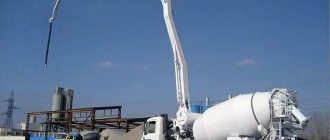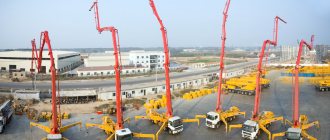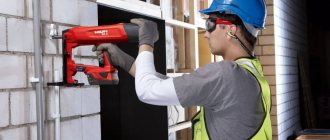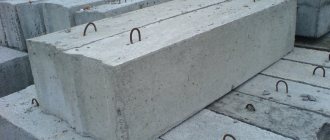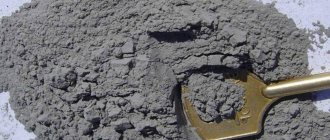A concrete mixer truck is a special machine designed for transportation and simultaneous preparation of concrete mixture. It is equipped with a rotating container into which the necessary ingredients for preparing concrete are poured. Below we will briefly consider the history of such transport, highlight its classification and types, and talk about the principle of operation. We will pay special attention to the best models based on the Kamaz vehicle.
How the first concrete trucks and concrete mixer trucks appeared
The history of concrete trucks and concrete mixer trucks began at the beginning of the 19th century in the USA. At first, separate mixers for transporting concrete appeared, and over time, concrete mixers on a chassis with the ability to load elements and prepare a solution on the way.
Stefan Stepanyan is considered the inventor of the first concrete mixer on a truck chassis. It was he who developed a new technical solution that gave impetus to the entire construction business. The operating principle of the machine is based on mixing the working composition inside the container during rotation. For his invention in 1954, Stepanyan received recognition from the National Cement Organization, and is still considered the “father” of this industry.
Few people know, but an application for a patent was sent by Stefan back in 1916, but then it was refused. The reason turned out to be the expert's doubts that the truck could support the weight. In 1928, he resubmitted the request and in 1933 the patent was finally received.
The reasons for this 17-year delay are still being debated. At the same time, in 1935, the preparation of concrete mixers intensified in the Soviet Union, and projects for two vehicles were developed.
One was used simply for transporting concrete, and the second was used for preparing construction mixture along the way. Over the next two years, 15 of these machines were produced. In 1937, a decision was made to unify such transport and combine the functions of a concrete truck and a concrete mixer.
Layout diagrams
Hanging system
It is used if the supply of concrete for pouring the structure (the foundation itself acts as it) is carried out over a short distance with an offset. To create such a structure, you will need a rope, from which the gutter is suspended using cables passing through two blocks.
One end of the rope is attached to a pole or column, and a load is hung on the opposite end and lowered to the ground. The load is also hung on the ends of the cables in such a way that they can be used to adjust the angle of inclination of the system.
If a system such as a foundation is to be erected for a large structure, then to maintain a constant angle of inclination it is necessary to install a taller rope tower or install additional pillars. It is the auxiliary pillars that will receive concrete from the main tower.
Gutters with jibs
This arrangement is appropriate if concrete for the foundation is supplied at a distance of no more than 60 meters.
The lower end of the gutter is suspended and attached to the jib.
The jib is a metal lattice truss, one side of which rests on the lower skid, and its upper edge is connected to the upper skid using a lifting cable.
In order for the slope of the gutter to remain unchanged while the concrete solution passes through it, its lower end is attached to the ground using cables.
Sprengel groove
The simplest design, which involves hanging the lower end of the gutter from a support.
Design and principle of operation
The trucks in question are designed to prepare concrete along the route from the point of filling with dry components to the construction site.
Important
Structurally, they are trucks with a special chassis on which a special pear-shaped drum is installed. Sometimes the tank is mounted on separate chassis or semi-trailers.
Structurally, a standard concrete mixer truck consists of the following elements:
- water container;
- loading device where gravel, sand and cement are added;
- drum (mixer);
- drive unit;
- self-loading device.
The pear-shaped concrete container is tilted 10-15 percent for better mixing. Inside there are 2-blade screws that help in stirring the finished mixture. When rotating in one direction, loading occurs, and in the opposite direction, unloading occurs.
Loading/unloading is carried out through special devices. In addition, a water supply system is used to clean the internal cavity and mechanism elements from concrete. Structurally, it consists of a system for creating pressure, dosing and supplying water, as well as storage tanks. In general, all construction mixers in the form of concrete mixer trucks are of two types according to the principle of operation:
- Gravitational. In such devices, the drum has the shape of a pear, and mixing occurs with the help of blades and raising the solution upward. Once the composition is delivered to the limiting level, it falls under the influence of its own weight, and then the cycle repeats.
- Forced. Unlike the type discussed above, the drum does not move. In this case, the working container has the form of a trough/cylinder, and the containers move on a fixed shaft. This allows you to maintain a constant concrete mixing process and greater efficiency.
Domestic concrete mixer trucks differ little in their operating principle and equipment. Such devices can operate in a wide temperature range from -30 to +40 degrees Celsius. In this case, the maximum loading speed when full should not exceed 60 km/h.
Requirements for transporting concrete
Requirements for the transportation of concrete solutions are specified in GOST 7473-2010 “Concrete Mixtures”.
Concrete mix
What should be considered when transporting concrete mixtures:
- The solution must be moved in such a way that the possibility of its loss is excluded.
- The possibility of sediment entering the mixture should be eliminated.
- The transportation method must ensure that the mass remains homogeneous.
- The time planned for transportation should not exceed the period during which the properties of the mixture are preserved (mobility and brand strength).
Transporting concrete using truck mixers is an effective way. Even moving it over long distances, it is possible to ensure that the mixture does not separate. Conditions are created that protect the cargo from the effects of sunlight, rain and other atmospheric phenomena.
The use of concrete mixer trucks makes it possible to produce the solution on the way to the construction site. To do this, the required amount of dry components of the mixture and water (in a separate tank) are loaded into the drum.
concrete mixer truck
When approaching the object (30...40 minutes before the finish), the dry ingredients are mixed with water, the concrete solution is ready for use.
Types and classification of concrete mixers
Today, many types of concrete mixer trucks are used, which differ in several parameters. Concrete mixer trucks are:
- Stationary. In such devices, the concrete composition is prepared in one place without the possibility of movement.
- Mobile. They are made in the form of trailed devices and can be transported from the place where construction materials are filled to the point of construction of the facility.
- Self-loading. They are a machine on a 4x4 chassis, which has the option of self-loading, a dosing system and the function of rotating the drum 300-360 degrees.
In addition, concrete mixer trucks are divided into several types according to the installation of the mixing structure and the direction. Main types:
- Unloading "backwards". A more convenient option for most cases, allowing the machine to drive to the desired location and unload concrete with maximum accuracy. Such concrete mixer trucks are in greatest demand in Russia.
- Unloading forward. The peculiarity of this method is that the driver can control the process and accurately direct the flow of finished concrete.
The rotation of the working part is carried out using a special drive, which comes in two types:
- Mechanical. In this case, power is taken from the power unit through a group of mechanisms: chain transmission, gearbox with reverse.
- Hydromechanical. Unlike the previous version, power is taken from an autonomous motor, power take-off or chassis engine. In all cases, the basis is the hydromechanical principle.
In most cases, the hydromechanical principle of rotation is used. Its essence is that the transmission includes a hydraulic pump, a hydraulic motor with reverse and a planetary gearbox. The hydraulic pump supplies the mixture to the hydraulic motor, which ensures rotation of the pear-shaped container with concrete. The peculiarity of the hydromechanical drive mechanism is the ability to continuously adjust rotation with the creation of pressure at the level of 18-22 MPa.
Depending on the type of mixer motor used, there are two options:
- Autonomous. It is reliable, but produces more noise during operation. If the motor is suddenly damaged, the concrete continues to mix.
- On the chassis. Such units are more environmentally friendly, have lower noise levels and help reduce the weight of the machine.
In addition, modern truck-based construction mixers differ in capacity. It can be from 4 to 12 cubic meters.
Disadvantages of solution preparation
Builders who want to save money make the mortar themselves, but completely forget that when laying the mixture in parts, the foundation ends up with worse technical characteristics. The concrete base turns out to be of poor quality due to the fact that stale cement, prepared many hours before its production, is used to lay it.
Construction companies provide concrete mortar, which is made using mixers with a volume of two to ten cubic meters. Manufacturing companies with a large turnover of products use specially designed vehicles to transport concrete mortar. The use of special equipment for transporting the mash increases the cost of the finished mixture.
Technical characteristics of vehicles on Kamaz chassis
In Russia, concrete mixer trucks based on Kamaz have become very popular. They are distinguished by their reliable design, long service life and ease of repair. Below we consider the most popular models.
Kamaz-581453
A truck equipped with a spacious concrete mixer capable of preparing up to 14 cubic meters. meters of solution in one go. The machine has a 3-axle design and a 6x4 wheel arrangement. The manufacturer has provided a high-quality hydraulic drive and a German power plant.
All the most loaded elements are made of high strength steel, which ensures a long service life of the machine. The equipment can be used to prepare the solution on site or loaded at another point with subsequent delivery to the construction site.
The advantages of the model include a powerful chassis, excellent all-terrain qualities, a convenient loading/unloading system and adaptability to domestic operating conditions. The drum is driven by a German HATZ-4M41 motor. The gearbox is made in Italy, is highly reliable and ensures correct transmission of torque.
Characteristics of KamAZ-581453:
- total weight - 27.5 tons;
- load capacity - 13.05 t;
- dimensions - 8.6x2.5x3.8 m;
- water tank capacity - 450 l;
- mixture volume - 14 cubic meters. m;
- loading / unloading height - 3.8 / 2.2 m;
- mixing time - 20 minutes;
- engine power - 320 horsepower.
KamAZ-58147s
The Kamaz 58147s concrete mixer truck is no less in demand in Russia. The equipment is manufactured on the basis of the “53229” chassis and is used for transporting concrete while maintaining its properties and subsequent unloading at the desired location. Can be operated in a temperature range from -20 to +40 degrees Celsius. It has an autonomous engine and tank, which ensures independent operation.
Features of the equipment include the presence of an Italian gearbox, which has a large reserve of torque and ensures reliable operation of the drive. In addition, an oil cooler made in Italy is installed, which extends the service life due to high heat transfer.
The most heavily loaded spare parts are made using special wear-resistant steel. The water supply system is heated by vehicle exhaust gases. The fuel pump is controlled using a special flexible cable.
Characteristics of KamAZ-58147s:
- total weight - 24 tons;
- dimensions - 9x2.5x3.7 m;
- water tank capacity - 450 l;
- mixture volume - 12 cubic meters. m;
- loading / unloading height - 3.7 / 2.2 m;
- mixing time - 20 minutes;
- engine power - 330 horsepower.
Kamaz-58149W
This is a concrete mixer truck on a Kamaz-65201 chassis with a 6x4 wheel arrangement. Designed for delivery of ready-made working mixture to the construction site. It has a restyled cabin with improved ergonomics and design. Features a redesigned mixing drum design, reduced weight of support rollers and improved rear support design.
The mixing drum rotates from the chassis engine with power take-off from the PTO. The work is based on a hydraulic drive system consisting of reliable elements. For example, a planetary gearbox is made in Italy or Germany. The oil cooler is also Italian or German made. The GST-90 gyrostatic transmission is made in Russia, and the elastic coupling is made in Germany.
Characteristics of KamAZ-581453:
- total weight - 33.1 tons;
- load capacity - 18.4 tons;
- dimensions - 8x2.5x3.8 m;
- water tank capacity - 800 l;
- mixture volume - 9 cubic meters. m;
- loading / unloading height - 3.8 / 2.35 m;
- engine power - 390 horsepower.
| Technical characteristics | Kamaz-581453 | KamAZ-58147s | Kamaz-58149W |
| Total weight, t | 27,5 | 24 | 33,1 |
| Load capacity, t | 13,05 | 15,9 | 18,4 |
| Dimensions (LxWxH), m | 8.6x2.5x3.8 | 9x2.5x3.7 | 8x2.5x3.8 |
| Water tank capacity, l | 450 | 450 | 800 |
| Volume of mixture, cubic meters m | 14 | 12 | 9 |
| Loading/unloading height, m | 3,8 / 2,2 | 3,7 / 2,2 | 3,8 / 2,35 |
| Engine power, l. With. | 320 | 320 | 390 |
Device
The design features of an automobile concrete mixer are determined by the need to prevent precipitation from entering the finished concrete mixture. The safety and uniformity of concrete is achieved by rotating the drum during movement.
The mixing drum is installed on the KamAZ chassis at an angle of 10 degrees. Special spiral blades are installed inside it. When they rotate in the opposite direction, the concrete mixture is unloaded. Concrete flows out of the container through installed gutters. One of them is installed directly in the concrete mixer, and the second is pulled to the machine at the unloading site. Special pumps can also be used for these purposes.
Competitors and leaders among manufacturers
On the Russian market you can buy concrete mixer trucks from different manufacturers. The most popular in 2022 include:
- ABS-10DA vehicle based on MAZ 6516S9 for Euro-5. The equipment has been selling well for many years; it has a spacious 12 cubic meter mixer, which reduces the number of trips for loading and unloading. The car is equipped with a German gearbox and an engine from France, which is assembled in the Russian Federation. There are also no difficulties with the basic chassis.
- CIFASL 10 on MAN TGS chassis. Despite the higher price, this machine is in great demand. It has a 10 cc capacity and is hydraulically driven by the chassis motor. The main feature of the drum is the non-standard location of the transverse seam, which has a slight offset. This ensures more efficient mixing and complete discharge.
- TIGARBO ABS-7DA is a concrete mixer truck based on the Maz 6312s3 chassis. It has a new modern cabin with pre-heating of the engine and a comfortable cabin. The drum drive is powered by an autonomous motor made in Germany or Russia (depending on the configuration). The total loading volume is 7 cubic meters, and the total weight is 29.5 tons.
There are other options on the market in the Russian Federation, such as TZA ABSN-29 with an 8-cubic-meter drum, Liebherr with drums with a volume of 6 to 15 cubic meters. Also popular are equipment from the Steller company with mixers of 6-15 cubic meters or lightweight machines from Deutz with tanks from 7 to 9 “cubes”.
When choosing, you need to take into account that domestic products will be cheaper, and this is what many companies in Russia focus on. The honored leaders include equipment for delivering concrete with a mixer based on Kamaz or MAZ. If you have the required amount, you can consider foreign versions of equipment.
Conditions and prices for delivery by mixers with a 10m long feed belt.
DELIVERY IN THE CITY
- Minimum delivery volume: 1m3.
- Minimum delivery cost: 6000 rub.
- Delivery cost over 6 m3: 1000 rub./m3
DELIVERY OUTSIDE THE CITY
- Minimum delivery volume: 1m3.
- Orders 6m3 – cost 1000 rub./m3 + 500 rub./m3 for every 10 km. outside the ring
- Travel post + 1000 rub./piece.
Free unloading time: 1 hour Quantity in stock: 2 mixers. Volume: 6m3, 8m3. Tape length: 10m. Feeding height: up to 3m.
We work in Stavropol: in the region, in the districts and in the region
Ours accepts orders for the purchase of concrete with delivery in Stavropol, the region and the region. We work in city districts, microdistricts: Aleksandrovskoye, Divnoye, Arzgir, Blagodarny, Budennovsk, Georgievsk, Grachevka, Izobilny, Ipatovo, Novopavlovsk, Kochubeevskoye, Krasnogvardeyskoye, Kursavka, Kurskaya, Levokumskoye, Mineralnye Vody, Neftekumsk. See also, Novoaleksandrovsk, Novoselitskoye, Svetlograd, Essentukskaya, Zelenokumsk, Stepnoe, Donskoye, Summer Headquarters, Mikhailovsk. Александровское, Дивное, Арзгир, Благодарный, Буденновск, Георгиевск, Грачевка, Изобильный, Ипатово, Новопавловск, Кочубеевское, Красногвардейское, Курсавка, Курская, Левокумское, Минеральные Воды, Нефтекумск, Новоалександровск, Новоселицкое, Светлоград, Ессентукская, Зеленокумск, Степное, Донское, Летняя Headquarters, Mikhailovsk, Kiselevka, 26th microdistrict, 12th microdistrict, 31st microdistrict, 2nd microdistrict, 28th microdistrict, 16th microdistrict, 10th microdistrict, 9th microdistrict, 11th microdistrict , 18th microdistrict, 3rd microdistrict, 13th microdistrict, 14th microdistrict, 4th microdistrict, 17th microdistrict, 8th microdistrict, 15th microdistrict, 6th microdistrict, 20th microdistrict , 24th microdistrict Hide
EUROEXPRESS
Concrete at manufacturer prices with delivery throughout the city and region
The site uses cookies. When using the site, we process your data so that interaction with our site is as informative as possible and meets your interests.
We accept payment
Contact us
Our address: Stavropol, Selektsionnaya str., 5v
Telephone:
Our partners
Benefits of using a mixer
The mixer is an automated concrete mixer that delivers a specified volume of concrete to the workplace. The advantages of mixers are as follows:
- laying with a mixer is carried out over several hours, which reduces the time for construction work;
- the quality of the finished solution from the mixer is higher than that prepared by hand;
- the mixture from the concrete mixer comes out to the required consistency, which simplifies the work of leveling the surface;
- pouring concrete from a mixer is carried out throughout the day, and when making the mixture manually, it may take a week to pour the solution;
- has no difficulties in calculating the amount of the required solution;
- the mixture prepared at the factory contains additives, plasticizers, and modifiers that improve the waterproofing of the building mass;
- obtaining a homogeneous structure by mixing the mixture in a concrete mixer during transportation.
Return to contents
What are the lengths of the trays?
The length of the tray is from one and a half to two meters; if necessary, you can use devices to lengthen it. These activities are carried out by the driver upon arrival at the place. When renting this special equipment, the tenant has the right to ask for additional payment for this.
What if the gutter is too short? Of course, you can take advantage of the power of people by moving all this concrete composition yourself. This method is perfect for delivery to a window or basement, where the hose cannot reach, but if large-scale construction is underway, then the option is unproductive. An advisable solution would be to build or use an additional tray.
When the distance is more than 5 meters, the mixture will not be able to flow on its own due to the small angle. To solve this problem, you will need a special concrete pump; using this device, it is possible to send concrete over a considerable distance. You can also use transport tape or a wider pipe. It will not be easy to get them locally, so it is better not to count on this option.

